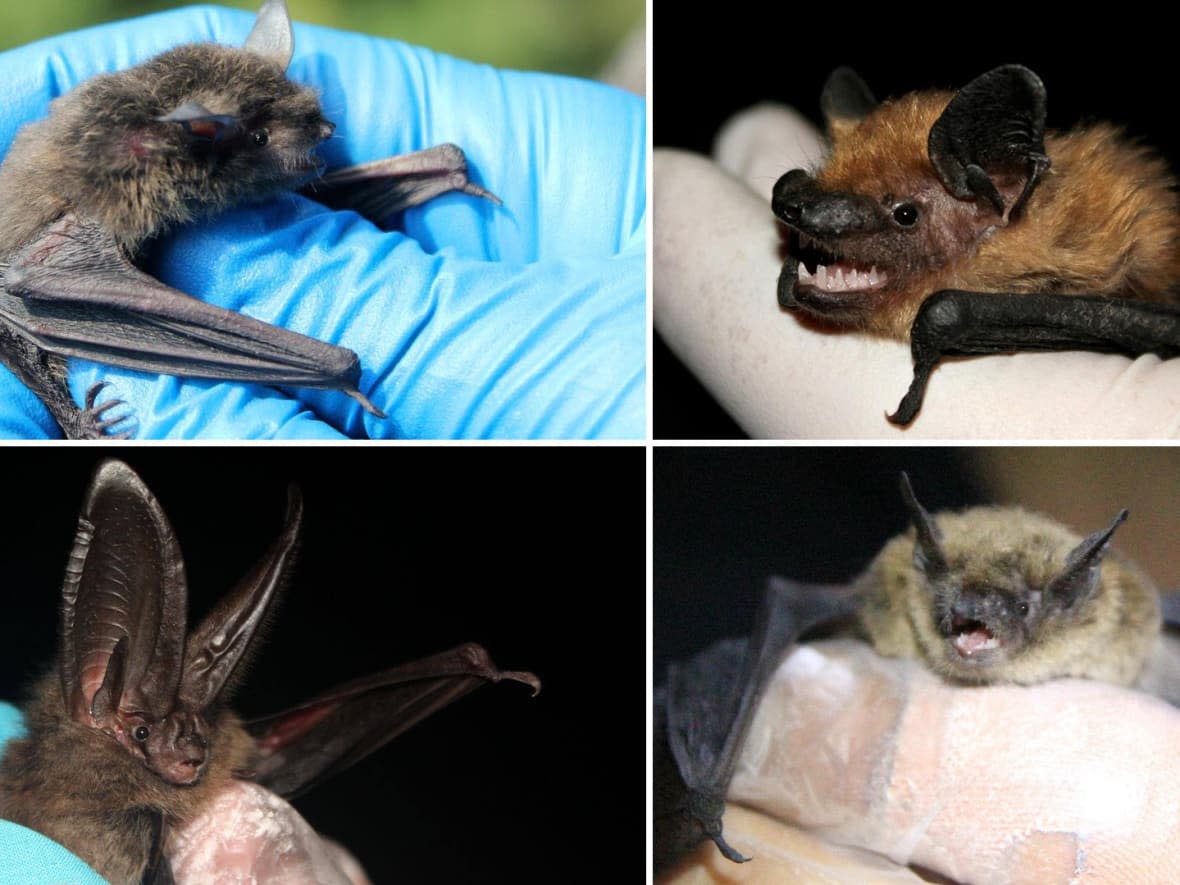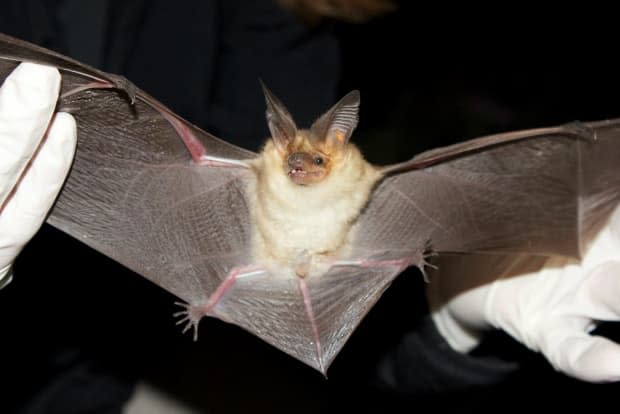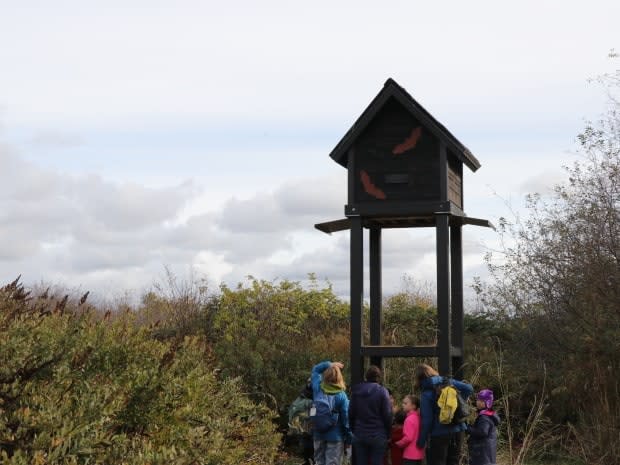Forget Halloween — here's the scary story of a fungus coming for B.C.'s bats

This Halloween, the scariest thing biologist Cori Lausen can think of is British Columbia without its bats.
For Lausen, a bat researcher at the Wildlife Conservation Society of Canada, it's a terrifying reality getting closer all the time.
A fatal fungus called white-nose syndrome, which has killed millions of bats in Canada, is closing in on B.C.
The fungus grows on a bat's nose, ears and wings in the winter. Bats will often starve to death because they burn through their stored fat trying to remove the fungus from their bodies. The fungus also rots their wings, creating holes and making it difficult for them to fly to catch food.
Scientists are raising awareness of white-nose syndrome during international Bat Week, which ends on Halloween — a nod to a species associated with all things spooky.
The syndrome has decimated bat populations in all provinces east of Manitoba. It's been found in bats in Saskatchewan and there are suspicions it's reached Alberta. The threat is also coming from the U.S., with cases of the syndrome now found within 100 kilometres of the Canadian border.
"It's squeezing us from all directions," Lausen said. "That fungus is going to come, if it's not already here."
Disappearing bats
White-nose syndrome is caused by a kind of fungus originating in Europe. It got the name because scientists first noticed it in bats hanging upside down, where their white noses and faces were most visible from the ground.
It's been in North America since at least 2006, according to groups that monitor its spread.

Unfortunately, there are significant barriers to tracking the advance of the fungus in B.C., says Lausen. Much of it comes down to funding, but there's also a huge backlog of samples waiting to be tested, after the lab that handles the testing was badly flooded during the atmospheric river that hit in November 2021. Testing hasn't resumed.
Scientists are also still working to understand where the bats go in winter. That's when many of them will die from the fungus, but it's hard to observe the bats when scientists don't know where they hibernate.
"It's a pretty gruesome death for these bats," Lausen said. "They're just kind of disappearing into crevices and maybe just not coming back out."
Critical species
Scientists who study bats say people shouldn't be afraid of them. People should, however, be afraid of losing them.
The loss of bats in an ecosystem is a big deal because of the critical role they play in managing insects and pests. The threats they face are key issues for international Bat Week.
There are 150 species of bats in North America and many are threatened by disease, loss of habitat and climate change, according to Environment and Climate Change Canada.
Eighteen species call Canada home. Western Canada has double the amount of bat species than what's found on the other side of the country, and many of the species in the West aren't found anywhere else, Lausen says. Many farmers encourage them to live near their crops to help reduce the need for pesticides.
"If you are grabbing some organic food off the shelf, you are depending on natural pest control, and that's what bats are," she said.

Each year, the flying mammals provide billions of dollars worth of pest control services to farmers in North America. Their role in keeping down critters on farms has been described as "essential" by the U.S. Fish & Wildlife Service.
White-nose syndrome alone costs the American agriculture industry up to $670 million US a year, according to a study by the University of Chicago.
All bats have the same iconic silhouette in the night sky, but up close, they're quite different, says Danielle Dagenais, a co-ordinator for the Community Bat Programs of B.C.
They can spend their lives in completely different environments, she says. Some live and hunt only in trees, while others like to skim over water to catch their food.
Their appearance is also diverse. The little brown bat, for example, grows only to the size of an adult's thumb, while the Townsend big-eared bat is known for standout facial features, like its huge, rabbit-like ears.
'Natural pest control'
Many bats also live where humans do.
Their whereabouts throughout the year depends on the season. Around Halloween, nearly all of them begin their hibernation somewhere. By March, females will migrate to their maternity habitat as a colony and if they have babies (known as pups), they'll usually be born around June.
Males generally stay alone and do not congregate.
In B.C., most species spend their lives in the Greater Vancouver area. There are even two certified "bat-friendly communities" in the Lower Mainland.

Despite that, typical habitats for bats are vanishing, says Dagenais. As urban sprawl and development continues, the need for alternative bat accommodation increases.
Old-growth trees and older houses — where bats will roost in roofs or attics — are disappearing and in some cases being replaced with sleek structures that have none of the usual crevices and hiding holes that a female bat can roost in for the summer, leaving many of them homeless.
Bat boxes (or "bat condos") are one way to make up for that habitat loss.
Groups like the South Coast Bat Conservation Society encourage residents in areas near a water supply or lots of trees to consider a box for their house or backyard, which can give hundreds or thousands of female bats a place to have a pup in the summer.
It's important work because maternal habitat spaces in urban centres like Great Vancouver are becoming more limited. Females can only have one baby a year, and many don't make it.
WATCH | White-nose syndrome, which has killed millions of bats in Canada:
There are other ways people can help support bat populations, such as planting native species in the garden or leaving outdoor lights off so they can navigate better at night.
Dagenais says people should also report bat colonies and sick or dead bats on their property to conservation groups, so they can monitor the movement of the mammals and the progression of white-nose syndrome.
People need to challenge their perception of bats, much of which has been based on myths, she said.
"They're tiny little species and they're just amazing at what they can do."
Bat facts:
On a warm summer's night, bats can eat their weight in insects.
Not all bats live in caves. Many roost in mines, on tree branches and even in tree roots.
There's no typical gestation period for a bat. It depends on how hot or cold the pregnant female is, plus how much food she can get.


